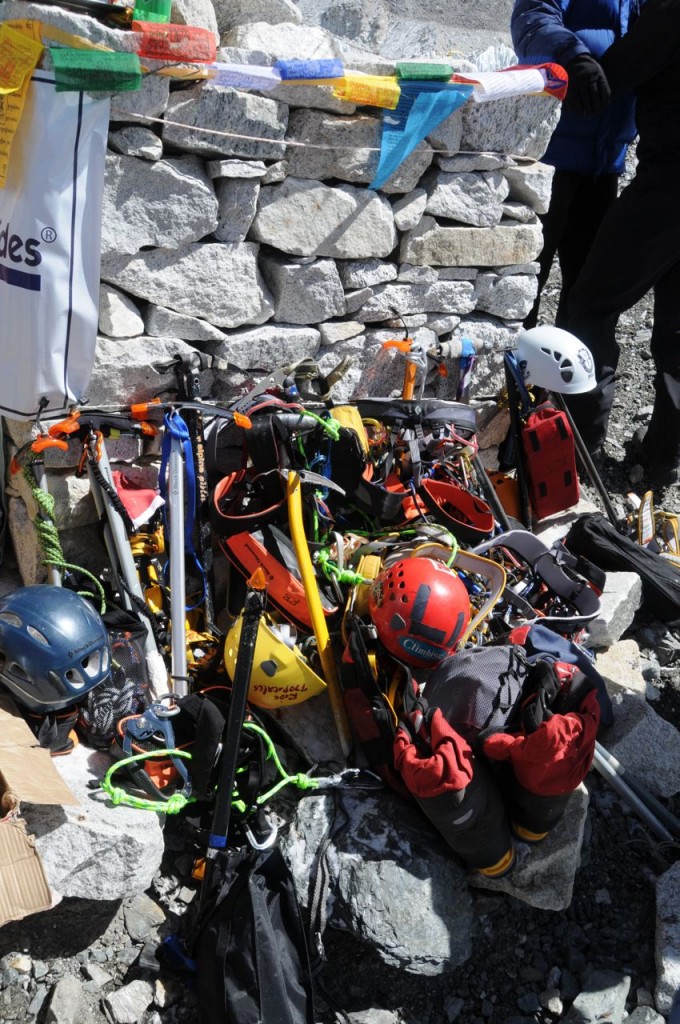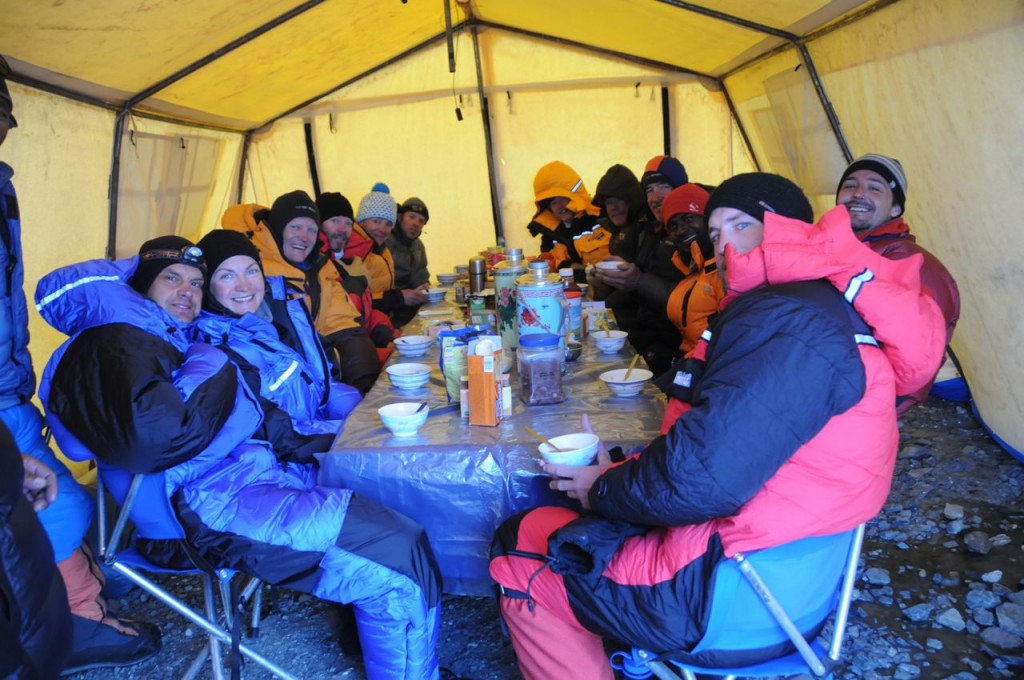Everest Equipment
Google it. There are plenty of long detailed equipment lists. An excellent source of information as well as …confusion. My personal insights into most important pieces of equipment are below. Highly subjective. (The names of the camps I refer to are based on the Everest Normal Route through the South Col / Nepal Side).
When I was buying / packing the stuff, I spoke to the people who had just come down. It helped a lot. If you need a speaking partner to bounce your packing list with – mail me and we will figure it out.
Base Camp life.
It appeared to be wrong. Logistics works in a way, that extra 1 kg of gear to the Base Camp is not a problem. The bottleneck is extra weight you want to pay for during air travel.Every climber has 2 duffels of equipment and gear, which gives plenty of space for a civilized shirt, pair of jeans and extra socks. Due to the nature of the expedition you spend a lot of time in the Base Camp between acclimatization climbs. The moment when you come down take a weekly shower and put on a “normal” shirt and a pair of jeans (in my case dream of a pair of jeans) is a bliss! The momentum is only comparable to a black tie event at the sea level.
For the Base Camp life you may want to have 2 pairs of pants. For example the soft shells you hiked in + another pair (or jeans).Washing clothes is possible, is necessary and is not so unpleasant if the sun shines. It turned out to be a nice social event, actually.
Do take playing cards or compact and light table games. Even if you are not a fun, chances are high you will become. Do take a paperback. One or two is enough – you can rotate with teammates.
Everest Sleeping Bag
Actually you need 2 for a comfortable life and they will fulfill different functions.
One is a warm sleeping bag for the Base Camp. The Base Camp is your resting and recuperating ground, so sleep is essential. At least – 20C (-4 F) / comfort will do. If you are cold-blooded, like myself, go with -30 C (-22 F) option. Base your choice on the following criteria: warmth, comfort and easy to wash. The bag has to be sturdy – it will be heavily used. Weight is not an issue, since you will have logistics in and out of the Base Camp. Therefore I recommend synthetic. It is also lighter on your wallet. Use this bag as a blanket for the trek in.
Second is an equally warm bag for sleeping high on the mountain. Here weight is an issue – you will carry it on your back up and down. I use down for the warmth / lightness ratio. It can be a more delicate and expensive piece of equipment. Logic tells you that it has to be even warmer than the Base Camp bag, but it is not necessarily true. The trick is that higher on the mountain (definitely Camp 2 & upwards) you are likely to have down suit or pants / jacket combo with you. Tossing it over your down bag will increase warmth. (OVER the bag, not inside the bag. Wearing down gear inside down sleeping bag not only restricts your movements but compresses the down on both: the bag and the down suit and it is not so warm any more). Many would use – 20 C (-4 F) bag. I went for – 30 C (-22 F).
Sleeping Matt
If you are joining a commercial expedition (or buying logistics from a provider) tents will be included and typically it will come with some sort of sleeping matt. Double-check what kind it is. If it is a good thick option – you are covered for the trek in and for the EBC. For higher up you need extra. To me a sleeping matt is as important as a sleeping bag, because without it buying an expensive sleeping bag is throwing money to the wind. Besides, a surface your tent is on may be far from perfect and a thick mat will make it bearable. I go with mats with warmth factor R 4,9 and higher. Other criteria – it has to be light, compact and easily self-inflatable. You have no extra resources to struggle with the matt up high and breath inflating adds a lot of moisture that turns to ice inside the matt.
Everest Boots
2 pairs of boots is a must: trekking shoes and hard-core triple boots a-la Olympus Mons / Millet Everest and alike. My trekking shoes were trusted SALOMON Elios (they have survived 5 years of hard core usage and are brilliant) and Olympus Mons. Consider extra footwear for added comfort on the mountain. Camp Boots would add a lot of pleasure to Camp Life. Best to have a slip-in pair: you do not want to mess with laces and zips in the tent. Take a size or two up to accommodate good socks and leave air for wiggling. No need to go for super-expensive specialized Camp Boots. Those are nice, but virtually any pair of generic light waterproof sport boots will do. Down booties are comfy, but need rubber sole – the Base Camp is on scree. Take flip-flops for showers on the trek and in the EBC.
I also took climbing boots (the kind you would take to 3000 – 5000m peak) and that was a complete waste of space. While they are nice for going up from the EBC to Camp 2, there could be weather conditions when temperature plummets, wind picks up and it gets too cold between Camp 1 and Camp 2 to wear them. Besides, you do not want to over-complicate logistics with your personal stuff between the Camps. Not so nice to have extra 2 – 3 kg of load on the way down from the summit. It turned out there are virtually no situations when you would need climbing boots other than the ones you are taking for the summit. For hiking on the rest days (like to Pumori Camp 1) ordinary hiking shoes are enough, while for training climb (Lobuche) you would prefer to put your triple boots on.
Electrical Heaters
They are expensive and heavy, need power to charge right prior to the climb and need extra handling care during transportation, storage and trek-in, but they do make difference in a peculiar manner. I had heaters on Aconcagua and Everest (and no heaters on Denali) and my personal conclusion is like that – electrical heaters is a good preventive measure. With right choice of footwear, when you feel generally OK most of the time, heaters will buy you extra tolerance if weather deteriorates or you need to wait for team members. If your choice of footwear is wrong – heaters will not warm-up frozen feet. Even on maximum power you feel only slight warmth (with bare feet) and not at all through a thick sock.
Chemical Heaters
I always have emergency stash of chemical heaters and I swear by them! Add one in each mitten and do not worry about frozen fingers. BUT on altitude some brands work well, some almost do not work at all. 3 things:
- open them up an hour – 30 min prior to departure from the camp to allow for start-up time.
- Often chemical foot-warmers are formulated to work with lower oxygen % and are better on altitude than chemical hand-warmers
- Jump-start them on the summit day from an oxygen bottle
Down gear
You need down top and bottom for cold nights in the EBC and for climbing from Camp 2 up. In theory it can be the same pants / jacket combo. The only disadvantage would be necessity to transport it on your back for every rotation and for the summit bid. Having a separate set of high-altitude down gear & EBC down gear improves logistics dramatically and allows to cash it up high during the first rotation. Besides, you can do with a lighter down parka in the EBC, combining it with other layers underneath.
Head Lamp.
Take two and take plenty of batteries. It gets dark fast and you will use it every evening for many hours during 2 months.
Neck buff.
2 is minimum. 3 are better. You have more? Take more! You will sleep in them, climb in them, live in them and buffs get dirty quickly. They do not weight anything and small pleasures like having a clean nice smelling buff in the morning brights up the expedition life!
Tools.
Take a Leatherman tool or a Swiss knife with lots of gadgets additionally to a light and portable pocketknife. You may need to re-do ropes, fix gear, and what not. Better have instruments handy.
Find out more about Everest:
Route Equipment Training Tips Sherpas


